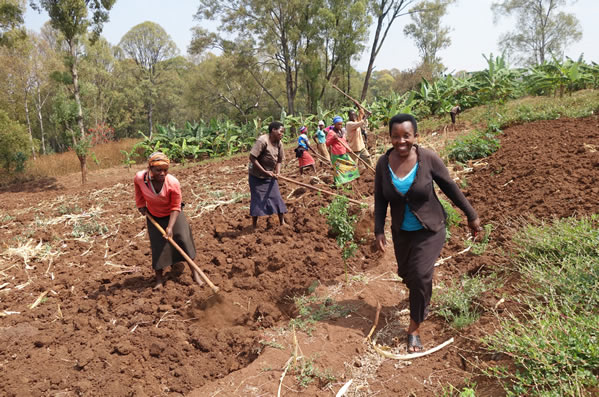Feeding the Sick with
Biointensive Farming
Rwandan hospitals lack resources to feed their patients; those without family to feed them, or who are very poor, often do not survive. Word of Mouth published an inspiring article by Medie Jesena Parrott about the Rwandan non-profit Kuzamura Ubuzima "Growing Health" (KU), which works with a large referral hospital in the Southern Province of Rwanda, feeding patients and their families using Biointensive farming methods adapted from an old copy of How to Grow More Vegetables. The large referral hospital, where KU started in 2015 and where it continues to provide services, has allotted over 10 acres of farmland, including more than one acre of banana plants and several avocado trees, for this project. Having adapted some biointensive methods to its climate and terrain, KU grows organic crops that are cooked by staff onsite with the help of able-bodied family members. They serve two highly nutritious meals per day to patients and their families; conduct teaching sessions about sustainable agriculture, healthy and hygienic food preparation, and balanced meals; and demonstrate stress management exercises, including yoga and qi gong. After four years, KU has not only expanded programming to include 125 patients at two hospitals, but has hired agriculture and health trainers, with the goal of having a more sustainable impact on the lives of the patients and families that we serve. The organization helps them survive the difficult period of hospitalization, but also wants them and their families to thrive after they return home, hopefully disrupting the self-perpetuating cycle of poverty and illness. In a tiny country as densely populated as Rwanda (the third most populous in Africa), where farm plots have been shrinking exponentially with every generation, subsistence farming using traditional methods has failed to provide adequate nutrition to families, and 35% of Rwandan children are stunted from chronic malnutrition. Biointensive farming was implemented by KU starting in 2015, working from my much marked-up and dog-eared "How to Grow More Vegetables" book signed by John Jeavons. It took some effort to calculate measurements from English to metric and to match up seasons of the year, but the principles of enriching and not exhausting the soil, conserving through composting and seed-saving, and following nature's own example through companion planting and crop-rotation made sense to adapt to local soil and crops. Most Rwandan farmers do use animal waste as fertilizer, but kitchen and garden waste are typically buried or burned. We broke a strong taboo and attracted attention with our mixed plantings on a large scale at our 10-acre hospital farm, so much so that our agronomist feared being cited for it. We continue to teach about keyhole kitchen gardens, which originated in Rwanda, as a way to employ biointensive practices. top | Newsletter Home |Table of Contents| Archive
|



